
WAGS NEWSLETTER
April, 2023
The WAGS Word
Welcome to the Q2 ‘23 edition of the WAGS newsletter. Once again, our team has put together some great educational articles for you. They continue to work hard to improve the bottom lines of our customers and it starts with being on the cutting edge of research to provide up to date scientifically guided recommendations.
We are proud to announce that due to the significant growth of the WAGS Saskatchewan business, we have moved into a larger warehouse in Swift Current. Our new Swift Current address is 2475 North Service Rd. West, Swift Current, SK, S9H 4X5. This expansion will allow us to better serve our Saskatchewan customer base.

Thank you for your business and the trust you have placed in our team. We wish you good health in your families and communities and for higher pig prices and lower ingredient prices in months to come!
Commodity Price Update
Grain prices decreased over the past months due to the extension of the Black Sea Grain Initiative. On top of that, inflation concerns surrounding Chinese demand and improved estimates for global ending stocks have also contributed to the bearish trend. Domestic prices have trended down with resellers dropping offers. The adverse weather in Argentina and soybean harvest delay in Brazil provided support for protein prices globally.
Crude oil value declined following recessionary and financial market concerns. After reaching levels under $73 USD in March, Brent crude oil futures strengthened and are trading near $82 USD currently. The market rose after Saudi Arabia, and several Gulf states decided to cut production by more than one million barrels of oil a day. Russia will also extend its cut of half a million barrels per day until the end of 2023. Crude oil prices are expected to remain volatile in the near term, which brings upside risks for cost of production and farmers planting intentions for this year. However, recession fears will keep limiting the upside trend.
After the Bank of Canada (BoC) held its benchmark rate at 4.5% on March 8, the Canadian dollar slipped over 1% to 72 cents against the US dollar. Canada has also experienced its sharpest slowdown in inflation in almost three years in February. Canada's Consumer Price Index (CPI) rose 4.3% year over year in March, which was also the smallest increase since August 2021. Besides the crude oil bullish trend, the US banking crisis has eased increasing the risk appetite and benefiting risk currencies like the Canadian dollar. The CAD is currently trading around the $0.74 level.
Corn futures declined due to better US acreage estimates and reduced exports. However, prices are still finding support on weather concerns in South America and the uncertainties around Black Sea exports. The US planting intentions and weather in Brazil and North America will be key drivers moving forward. Corn delivered to Lethbridge/AB is being traded around $415-$425 per MT and at $410-420 per MT delivered to Saskatoon/SK. Prices are expected to soften around June due to the Brazilian harvest pressure.
Wheat prices have also softened due to increased acreage estimates for US and Canada, as well as Russian exports. Delivered price indications in Red Deer/AB are at $420-425 per MT and at $410-420 per MT delivered to Saskatoon/SK. Uneasiness over whether a current Black Sea shipping deal will continue to get extended, and the US weather outlook will remain contributing to the bullish sentiment. On top of that, US spring wheat planting intentions are down by 2%, estimated at 10.6 million acres.
Barley delivery prices in Lethbridge/AB are at $410-420 per MT. Prices declined due to a higher usage of corn in feed rations and reduced local demand. Prices are expected to soften further but the remaining upside risks for global grain market could add volatility in the near term.
Soybean meal received support from the adverse weather in Argentina and harvest delay in Brazil. Argentinian production is currently estimated at 29 million tonnes, down from the 33.5 million tonnes previously estimated. Tighter than expected US soybean oilseed stocks have also contributed to the bullish trend. Prices are currently ranging around $770-780 per MT in Saskatoon/SK. A downside trend is still forecasted due to the Brazilian harvest pressure. Brazilian soybean exports could reach 90 million tonnes for the first time in 2023.
Canola meal prices declined and are trading around $490-$505 per MT in Saskatoon/SK. Heavy farmer selling has pressured canola futures over the past month, but prices have found support again on the crude oil bullish trend. The canola oilseed market is well supplied, and prices could soften further following to Brazilian soybean exports. Global inflation will keep adding volatility to the market.
We expect grain prices to decline once we get close to June’23 due to the Brazilian corn harvest pressure. This will depend on South American weather, but the estimates are positive so far. Weather and planting intentions in the US will also be important drivers as we move forward. Protein prices are also expected to decline but will depend on Chinese imports, crude oil prices and global economy outlook.
Synthetic amino acids are still on a downside trend and prices are expected to remain relatively flat in the near term. Amino acids prices are getting close to the bottom as we near cost of production and there are little upside risks currently in the market. However, prices could increase at some point following input and manufacturing costs.
PIG TALK
Feeding the Gestating Sow
While the list of nutrients required by sows and how they are used have remained much the same, pig production has changed dramatically along with genetic improvements, with the modern sow producing large litters sizes and weaning high numbers of pigs per litter, thus requiring sound nutrition and feeding strategies to achieve high levels of production. The goals of the feeding program for gestating sows are to achieve an appropriate sow weight during gestation and maximize reproductive performance while meeting the sow’s nutrient requirements in a cost-effective manner. Overfeeding gestating sows results in unnecessary feed expenses and potential problems such as abnormal mammary development, increased rate of stillborn and reduces feed intake during lactation.
Establishing nutrient requirements and feeding level
The pregnant sow requires nutrients and energy for maintenance, fetal growth and maternal weight gain. These 3 components can be estimated individually, and their sum represents the sow’s total daily nutrient requirement. Maintenance represents 75-85% of the total energy requirement of the pregnant sow (Noblet et al., 1990). Maternal weight gain accounts for 15-25% of the energy requirement of the sow. While the developing litter and its supporting tissues account for about 20 kg of the total weight gained during pregnancy (Aherne et al., 1999), this component only requires 3-5% of the sow’s energy requirement because these tissues have a high-water content.
Determining the adequate feeding level is key to the success of a gestation feeding program. Proper feed allowance ensures large-heavy litters and creates body reserves for the upcoming lactation. Gilts should gain approximately 54 − 59 kg in their first gestation, 50 − 54 kg weight gain for first parity sows, 36 − 41 kg for parity 2 to 5, and 29 kg for parity 6 and older sows (Johnston et al. 2010). Sows draw on body reserves during lactation to support milk production, and with little backfat, a thin sow will mobilize her protein tissues as an energy source to meet her needs. If a lactating sow mobilizes more than 12% of her protein stores, the litter growth rate is reduced and subsequent reproductive efficiency will likely be compromised (Clowes et al., 2003). However, excessive weight gains during gestation predispose sows to poor performance during lactation as mentioned above.
Establishing the correct feed allowance
1) Condition scoring. Need to first establish a base feeding level and then adjust it up or down according to the body condition score of the sow. Feeding levels of 1.8 to 2.5 kg/day during gestation will be satisfactory for most pregnant sows. Sows can be subjectively scored visually (Figure 1) on a scale of 1 (thin) to 5 (fat) and are fed to achieve an “ideal” condition score of 3 at farrowing. This system is not accurate as the perceived “ideal” target varies between observers. Thus, what is considered proper body condition by one observer may be viewed as under or over-conditioned by another observer.
The sow body condition caliper is an alternative to visual scoring. The sow caliper is a fast and accurate tool that objectively measures sow body condition. The sow caliper technology is based on the presumption that the sow’s back becomes more angular as she loses weight, fat and muscle (Knauer and Baitinger, 2015). The sow caliper measures the angle between the dorsal and transverse process of the sow spine at the level of the last thoracic rib (figure 2). Through thousands of measurements, a validated measuring method has been developed, showing that this angle has a high degree of correlation with the sows’ body condition. Sows scored 11 and below are considered thin, sows in ideal condition are scored 12−15, and fat sows have scores above 15.
Sows need to be condition-scored periodically to determine if the feeding level needs to change to achieve the desired condition score at farrowing. Obtaining body condition measurements using the caliper at weaning, pregnancy check (~30 days) and at 60 days of pregnancy can be helpful to determine if a feed allowance adjustment is needed to achieve the targeted condition score.
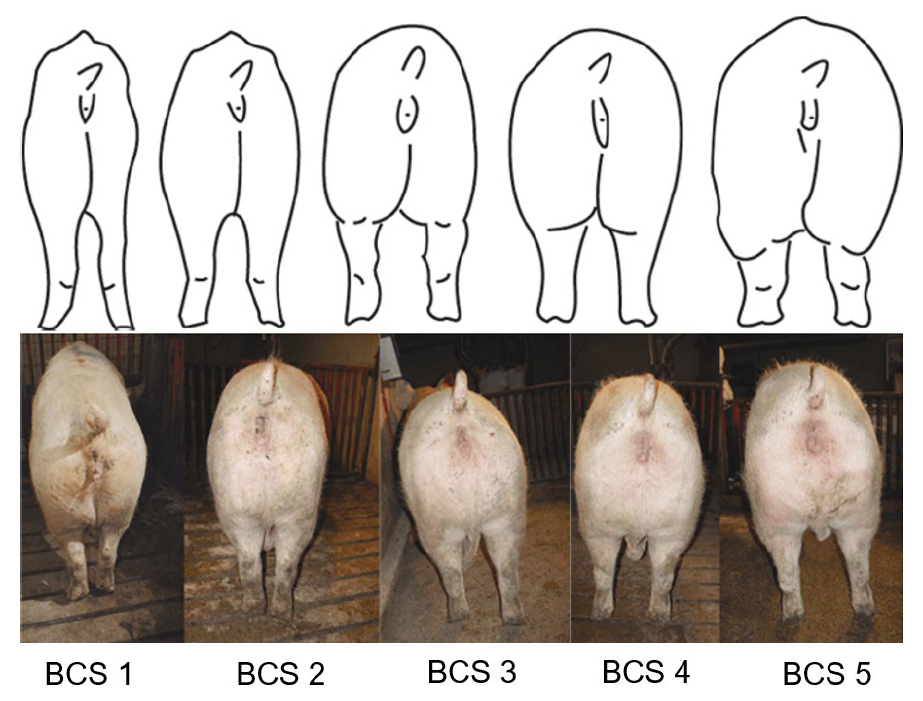
Figure 1. Visual body conditioning . Body Condition Scores (BCS) are arranged from 1 (left) which is assigned to emaciated sows to 5 (right) for very fat sows. A score of 3 is ideal. From Dr. Ken Stalder and National Hog Farmer magazine.
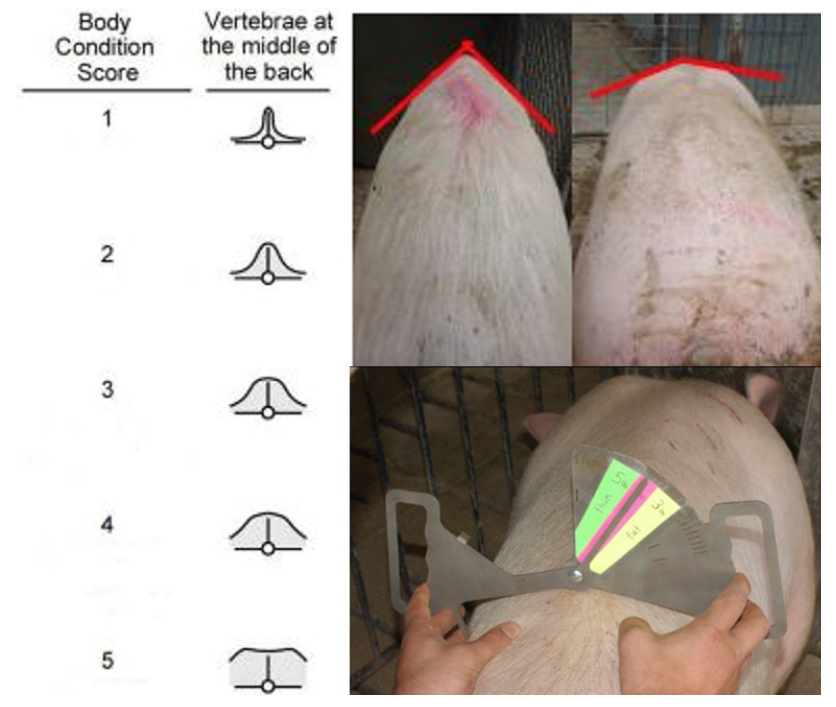
Figure 2. Caliper body conditioning. The caliper measures the angle between the dorsal and transverse process of the sow spine at the last rib. This angle has a high degree of correlation with the sows’ body condition. From Knauer and Baitinger, 2015 .
2) Backfat thickness and body weight. The backfat level is a good indicator of the sow’s body reserves. The less backfat a sow has, the fewer reserves she has for the lactation period. Backfat can be measured directly with an ultrasonic probe. This measurement is more accurate than visual conditioning scores. Additionally, it is important to accurately determine the body weight of sows as body weight determines the majority of nutrient requirements of a gestating sow. The best way to do this is to weigh sows with a scale. However, in the absence of a scale, sows’ weights can be estimated using a flank-to-flank tape.
Feeding tables based on sow weight and backfat categories (at breeding) have been developed (Table 1). This method reduces the number of over-conditioned sows and reduces overall gestation feed costs thanks to more precise feed allowance when compared with feeding based on visual body condition scores. Thin and fat lactating sows represent a challenge, with fat sows being a more complex issue that affects productivity and profitability. Some of these consequences are, a) higher cost of production; b) abnormal mammary development; c) higher stillborn rates and prolonged labour; d) reduced lactation feed intake; e) large body weight loss during lactation; f) prone to lower litter size in the subsequent litter; g) higher sow death loss (Theil et al., 2022).

Table 1. Example of a gestation feeding table based on backfat and weight, lb. (Young et al., 2004).
Feed delivery systems should be checked at least quarterly to verify the amount of feed that is getting delivered versus what is expected. This is particularly important for systems that use volumetric measures to set feed allowance. Changes in rations density will change the amount of feed that these systems deliver to sows. Furthermore, the design of the feed drops, and method of installation (angle of the hopper) can impact the amount of feed it delivers.
Bump feeding is a common practice in sow gestation feeding. Bump feeding is intended to support the increase in energy and nutrient demands of gestating sows in the last third of gestation by increasing the amount of feed given to sows in late gestation. However, bump feeding studies consistently demonstrate that increasing nutrients and energy intake in late gestation is only partially used to improve piglet birth weight; by only 30 grams per piglet on average (Gonçalves et al., 2016). Rather, sows use the extra nutrients for weight gain, leading to heavier gilts and sows, increasing the stillborn rate by 2% (Gonçalves et al. 2016; Mallmann et al., 2019). The nutritional impact on piglet birth weight is limited likely because modern sows have an improved feed efficiency and propensity for growth. Roughly, a 1-kilogram increase in daily feed allowance from day 90 of gestation to farrowing leads to a 7 kg increase in body weight of gilts and sows (Gonçalves et al., 2016).
In conclusion, nutrition is crucial to ensure the modern sow achieves her genetic potential for reproduction. This can be achieved by feeding sows a properly balanced diet and basing daily feed allowances according to an estimate of sow body weight and backfat thickness, or by using an objective body condition evaluation tool such as the sow caliper. Score body conditioning sows and testing feed drops periodically help to determine if feed allowance adjustments are needed to achieve the target condition score. Finally, bump feeding not only has little or no effect on piglets’ birth weight, but it also results in higher feed costs, and negative effects on sows because a fatter sow will have more stillborn and higher pre-weaning mortality.
Note: References available upon request.
IT'S CHICKEN FEED
Promoting Gut Health Through Dietary Additives
Gut health is the macro and micro structural integrity of the gut, the balance of all the micro-organisms that live in the gastrointestinal tract (GIT) and the immune status of the intestinal tract (Choct, 2009).
The gastrointestinal tract is the major organ for nutrient digestion and absorption, it is also the first protective mechanism against pathogens that are transmitted orally (Choct, 2009). A gastrointestinal tract that has been challenged with coccidiosis, necrotic enteritis, salmonellosis, or other infections is not efficient in digesting, transporting nutrients or protecting the body against pathogens. Thus, maintaining or enhancing gut health is essential for the productivity and welfare of farm animals (Choct, 2009).
Figure 1. shows pictures of turkey intestine with different severity of macroscopic lesions caused by Eimeria meleagrimitis and Clostridium perfringens.
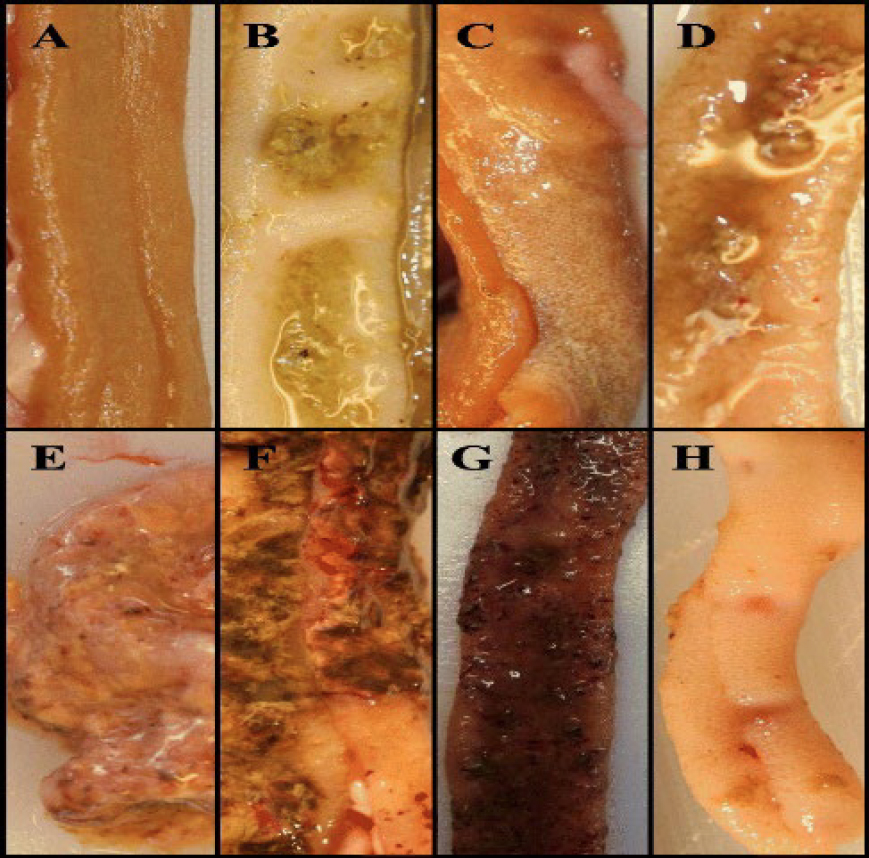
Figure 1. Photos of small intestinal mucosa from turkeys. A (normal). B (mild changes: pale mucosa and increased amount of watery intestinal contents). C (moderate changes): swollen, pale villi. D-G (various sub-types of severe changes). H: (mucosal depressions suggesting healing multifocal necrotic enteritis). Adapted from https://bmcvetres.biomedcentral.com/articles/10.1186/s12917-020-2270-5/figures/1
Antibiotics are very effective in controlling bacterial infections and as growth promoters when used at subtherapeutic levels; however, the use of medically important antimicrobials needs to be reduced as an effort to fight antimicrobial resistant (Kim, 2021). In Canada, since 2018, all medically important antimicrobials for veterinary use are sold by prescription only. Alternatives to enhance growth and performance and promote gut health through the feed are: probiotics, prebiotics, essential oils, short and medium chain fatty acids and organic acids.
Probiotics. Probiotics are living microorganisms that transmit health benefits to the host when administered in adequate amounts, they help in controlling infections thus improve animal production. Most common bacteria used as probiotics are lactic acid producers, such as Enterococcus, Lactobacillus, Pediococcus, Streptococcus, Lactococcus, Vagococcus, Leuconostoc, Oenococcus, Weissella, Carnobacterium and Tetragenococcus (Reuben et al., 2019). The main mode of actions of probiotics against pathogens are intestinal barrier enhancement, competition for adhesion sites and nutrients, production of antimicrobial substances, and modulation of the immune system. (Lau et al., 2018). Figure 2 shows the picture of Pediococcus acidilacticici using Scanning Electron Microscope.
Probiotics also produce volatile fatty acids (VFAs) like butyric acid which is absorbed by the gut cells and is used as a source of energy. Volatile fatty acids are used by the cells and this improve cell proliferation and cell repair (Wang et al., 2020)
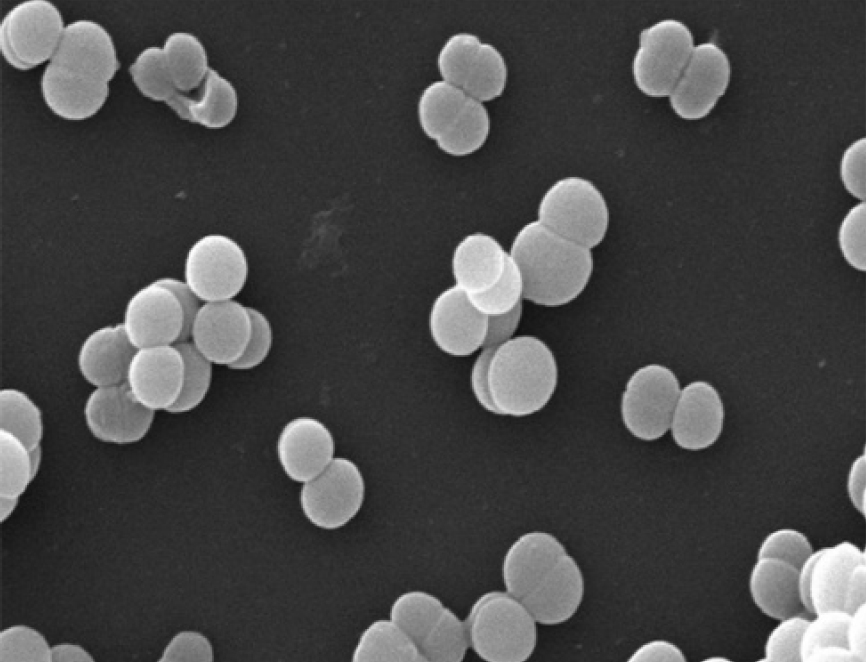
Figure 2. Pediococcus acidilactici. Adapted from https://www.hindawi.com/journals/bmri/2013/583850/
Prebiotics. Prebiotics are non-digestible substances that modulate the gastrointestinal microbiota composition and metabolism. Prebiotics provide the energy required for growth of favorable bacteria in the gut, enhance the immune adhere to intestinal cells. Prebiotics are a group of carbohydrates, the best-known are mannan-oligosaccharides (MOS), galacto-oligosaccharides (GOS) and fructo-oligosacharides (FOS)(Abd El-Hack et al., 2022).
Short and medium chain fatty acids. Fatty acids are made of chains of carbon atoms and hydrogen atoms, they are fat soluble. Short and medium fatty acids can give off hydrogen ions and lower the pH of solutions. Table 2. Shows a list of fatty acid with potential antimicrobial capacity and its classification (Gomez-Osorio et al., 2021)
Table 2. Potential antimicrobial fatty acids.
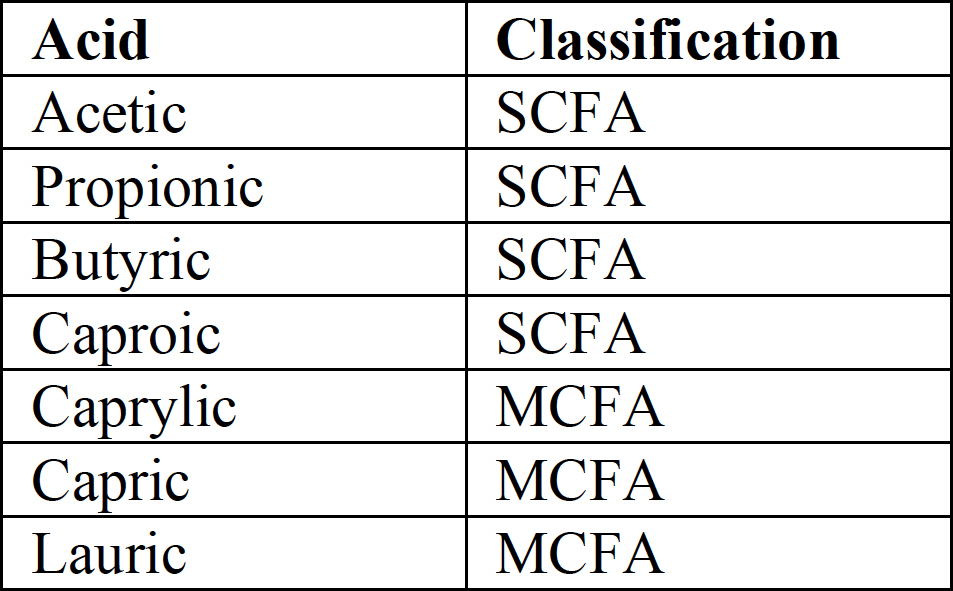
Short Chain Fatty Acid (SCFA) six or less carbons. Medium Chain Fatty Acid (MCFA) seven or more carbons. Adapted from (Gomez-Osorio et al., 2021)
Short and medium chain fatty acids have bactericidal and bacteriostatic effect. Bactericidal means that it kills the bacteria and bacteriostatic means that it inhibits the growth of the bacteria. Fatty acids act on the membrane and inside the bacteria. They increase the fluidity, solubility, permeability, and instability of the membrane causing the bacterial fluids to leak out resulting in death. Inside the bacteria, the hydrogen protons of the fatty acids dissociate and reduce internal pH, this interferes with the amino acids, enzymes and with the production and expression of virulence factors, limiting the ability of bacteria to grow. Also, when the hydrogen levels rise, the bacteria will use up all their energy to expel the excess hydrogen protons which leads to death (Gomez-Osorio et al., 2021).
Organic acids. Organic acids are biochemical compounds with a hydrogen donor group. Medium and short chain fatty acids are included in this definition. Dietary organic acid-supplementation can enhance gut structure integrity, physiological functions, intestinal immunity, health and antioxidative status, reduce lipid oxidation, regulate the immune response of the birds, improve nutrient utilisation, and suppress pathogen growth. All these properties could translate into improvements in growth performance, improve feed efficiency, improve laying performance, meat and egg quality. (Ebeid & Al-Homidan 2021).
Commercially different companies offer a variety of products that use these technologies. The available products might use a single kind of technology or a combination of them. At Western Ag Supply we have the experience and expertise to evaluate and make recommendations upon the products available in the market. If you have questions or are interested in exploring these alternatives don’t hesitate to get a hold of us and we will be happy to walk you through the different options and their pros and cons.
ITS A MOO POINT!
Potassium Carbonate as Feed Additive for Dairy Cows
Chemistry. Potassium carbonate an inorganic compound with the formula K₂CO₃. It is a white salt which is soluble in water and forms a strong alkaline solution. It is deliquescent, often appearing as a damp or wet solid. With regard to the industrial use, potassium carbonate is mainly used in the production of soap and glass. In pure potassium carbonate powder, there is 56% potassium found weight-to-weight-wise, and the rest is the carbonate fraction (1). Potassium carbonate dihydrate (K2CO3.2H2O) is a commonly found form in nature and may also be a white powder. It is produced when potassium carbonate (dry salt) absorbs water (moisture) from air. Then potassium carbonate and water are called the dehydrated form and with high exposure to moisture it tends to become deliquescent (wet salt) lowering potassium %. It is a strong alkaline solution that garners a variety of uses. The salt tastes like salt and alkaline material.
Feed additive. Feed grade potassium carbonate is a white, granular compound used to supplement the diets of production and/or companion animals with potassium to meet their nutritional requirements, including proper cation/anion balance, especially in potassium deficiency situations. Potassium carbonate can be added to dairy cattle feed as a source of dietary potassium. Potassium is an essential mineral for proper animal growth, reproduction, and milk production. Potassium is also naturally available from forage and grain. In dairy cattle, adequate potassium intake has been linked to improved milk yield, milk composition, and reproductive performance.
Benefits. One study conducted in Iran found that supplementing dairy cattle feed with potassium carbonate increased milk yield and improved milk composition, resulting in higher milk fat and protein content (2). Another old study conducted in Israel found that supplementing the diets of high-producing dairy cows with potassium carbonate improved fertility and reproductive performance (3).
Additionally, a review of several studies published in the Journal of Dairy Science concluded that potassium carbonate supplementation in dairy cattle feed can improve milk yield, milk quality, and reproductive performance (4).
Harm. While potassium carbonate can provide benefits when added to dairy cattle feed, there are also potential negative effects to consider. Overconsumption of potassium can result in toxicity and negatively impact animal health.
Potassium requirement. The potassium requirement of a dairy cow can vary depending on factors such as age, weight, and stage of lactation. However, according to the National Research Council (NRC), the recommended dietary allowance (RDA) of potassium for a lactating dairy cow is approximately 1.2% of dry matter intake (DMI), or about 90 grams per day for a 550 kg (~1200 lb) cow producing 45 kg (~100 lb) of milk per day (7).
It is important to note that excessive potassium intake can lead to health problems, such as milk fever, in dairy cows. Therefore, it is essential to balance the potassium content of the cow's diet with other essential minerals such as calcium and magnesium.
Therefore, potassium supplementation in dairy cattle feed must be carefully balanced with other dietary minerals, such as sodium and chloride, to ensure proper mineral balance and prevent negative effects on cows’ health.
Note: References available upon request.
ANNOUNCEMENTS
INDEXING
3rd Hillridge Farming Co.
6th Wymark Farming Company Ltd.
7th New Dale Hutterian Brethren
8th Bert Dunsbergen
10th Vanguard Farming Co. Ltd.
HEALTH/QUALITY TATTOO
1st Wymark Farming Company Ltd.
2nd Sand Lake Farming Co. Ltd.
4th Vanguard Farming Co. Ltd.
6th R. Valley Farming Co. Ltd.
LEAN PERCENTAGE & LOIN DEPTH
Lean Percent Target
2nd Vanguard Farming Co. Ltd.
3rd Wymark Farming Company Ltd.
8th Bench Farming Company
9th Bert Dunsbergen
Loin Depth Target
1st New Dale Hutterian Brethren
4th Sovereign Farming Company
7th Raley Colony Ltd
CORE AREA AND SORT
% in Core Area
2nd Hillridge Farming Co.
4th New Dale Hutterian Brethren
5th Raley Colony Ltd.
6th R. Valley Farming Co. Ltd.
7th Bert Dunsbergen
Carcass Wt. Target
2nd Raley Colony Ltd.
3rd R. Valley Farming Co. Ltd.
4th Hillridge Farming Co.
5th New Dale Hutterian Brethren
7th Bert Dunsbergen
Congratulations to Leusink Dairy Ltd for winning the Alberta Provincial Milk Quality Award for 2021 to 2022.
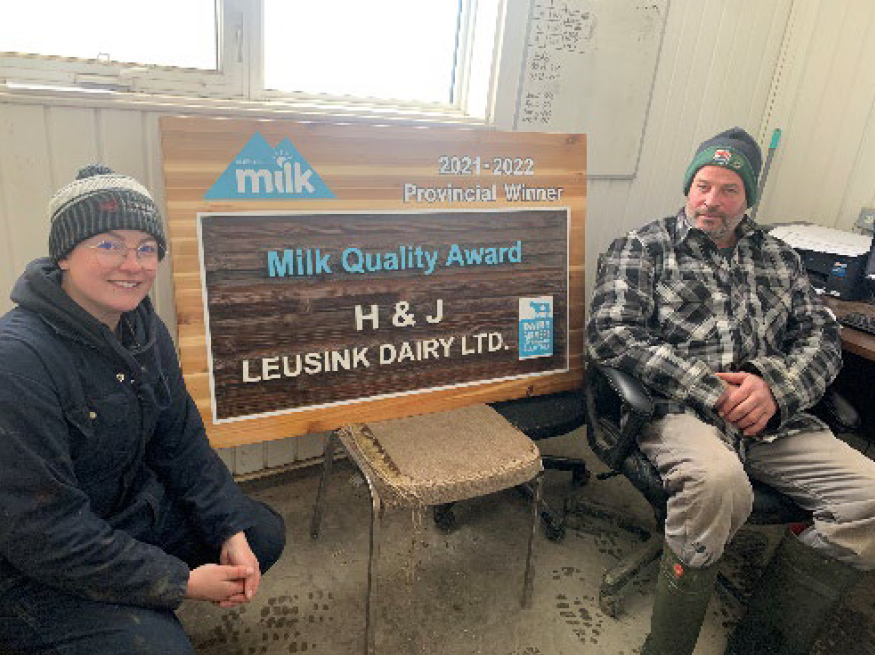
Well done to our friends at Vanguard Colony for winning 1st place in the carcass competition at the Cramer show in Saskatchewan last Feb. 9. Bench Colony won 5th place.
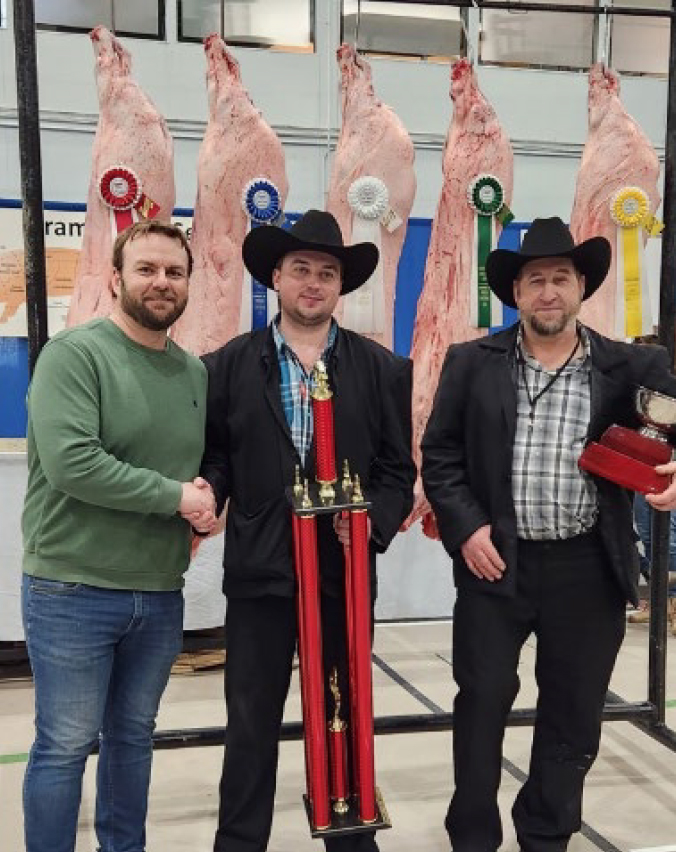
L-R. Darcy, Travis, Mike (Vanguard Colony)

L-R. Darcy, Marcus (Bench Colony)
THE WAGS TEAM
David Borsboom – Sales Manager
Harry Korthuis – Sales Manager
Darcy MacDonald – Sales Manager
Doug Richards – Sales Manager
Tony Rock – Sales Manager
Gordon Van Dasselaar – Sales Manager
Denni Van Dasselaar-Sales Manager
Anne Dyck-Office Assistant, Lethbridge, Alberta
Hailey Moors – Office Manager, Lethbridge, Alberta
Darlene Thorburn – Office Coordinator, Swift Current, Saskatchewan
Jake Adams– Warehouse Coordinator, Great Falls, Montana
Saman Abeysekara – Ruminant Nutritionist
Benjamin Londono – Poultry Nutritionist
Darren MacLeod – Swine Nutritionist
Mario Rebolledo – Poultry Nutritionist
Joaquin Sanchez Zannatta – Swine Nutritionist
Danilo Sotto – Swine Nutritionist
Tom Dowler – General Manager
